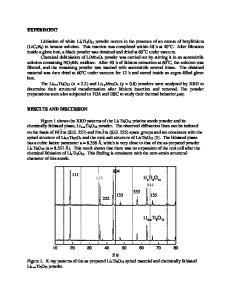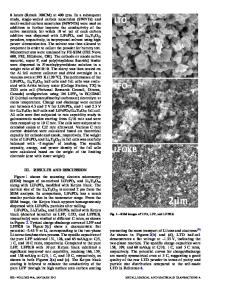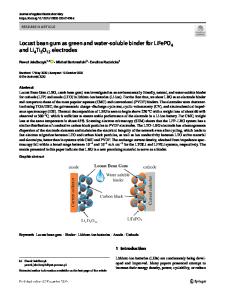Synthesis, Structure, and Electrochemical Properties of Li 4 Ti 5 O 12
- PDF / 1,280,006 Bytes
- 6 Pages / 612 x 792 pts (letter) Page_size
- 98 Downloads / 358 Views
0973-BB05-09
Synthesis, Structure, and Electrochemical Properties of Li4Ti5O12 Chintalapalle V. Ramana1, Satoshi Utsunomiya1, Rodney C. Ewing1,2, Udo Becker1, Karim Zaghib3, and Christian M Julien4 1 Geological Sciences, University of Michigan, 1100 N. Univ. Ave., CC Little, Ann Arbor, MI, 48109 2 Materials Science and Engineering, University of Michigan, 1100 N. Univ. Ave., Ann Arbor, MI, 48109 3 Chemical and Environmental Technologies, Institut de Recherches d'Hydro-Québec, 1800 Boul. Lionel-Boulet, Varennes, Quebec, J3X 1S1, Canada 4 Institut des Nano-Sciences de Paris, Université Pierre et Marie Curie, Campus Boucicaut, 140 rue de Lourmel, Paris, 75015, France ABSTRACT Lithium titanium oxide (Li4Ti5O12) spinels are promising negative electrode materials for application in energy technology. In this work, we have synthesized Li4Ti5O12 and investigated its structure, electronic properties, and electrochemical features using several analytical spectroscopy and microscopy-based techniques. The equally spaced fringe pattern indicated by the high-resolution transmission electron microscopy (HRTEM) along with electron diffraction revealed that the grown Li4Ti5O12 is well crystallized in the spinel structure without any indication of crystallographic defects such as dislocations or misfits. The electronic structure determination using high-resolution X-ray photoelectron spectroscopy (XPS) coupled with compositional studies using energy dispersive X-ray spectrometry (EDS) indicated the excellent chemical quality of the Li4Ti5O12. Under the optimal synthetic condition, the sample delivers a discharge capacity of 161 mAh/g at C/12. The good cyclability of Li4Ti5O12 is attributed to the small expansion (∆V≈1%) of the elementary unit-cell. INTRODUCTION Recently, lithium titanium oxide spinels are becoming the promising negative electrode materials in terms of the intercalation potential, cyclability, and rate capability for the development of polymer (or ceramic) lithium-ion batteries and hybrid supercapacitors. The [M2]O4 framework of an Li[M2]O4 spinel is an attractive host structure for lithium insertion– extraction reactions because it provides a three-dimensional network of face-sharing tetrahedra and octahedra for lithium ion diffusion. The zero-strain insertion material Li4Ti5O12 (Li4/3Ti5/3O4) was intensively studied because it exhibits the best behavior and reversibly inserts 0.7–1.0 Li per mole of oxide at 1.55 V leading to a specific capacity of 150 mAh/g (against a theoretical capacity of 175 mAh/g) [1-8]. The exceptional stability of this electrode to electrochemical cycling has been demonstrated by Rossen et al. [4] and can be attributed to the stability of the [Ti1.67Li0.33]O4 framework and to the minimal dilation (
Data Loading...











